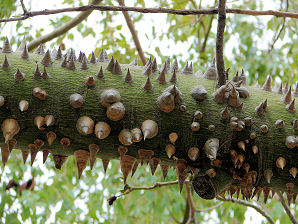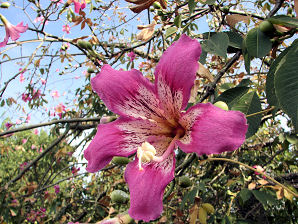Xeriscape Landscaping Plants For The Arizona Desert Environment.
Pictures, Photos, Information, Descriptions,
Images, & Reviews.
Trees.
Silk Floss Tree, Ceiba speciosa.
Click On Any Of The Following Links By Amazon.Com
For Books, & Videos About Wildflowers Of Arizona & The Southwest USA. No Obligation!
 |
| Silk Floss Tree, Ceiba speciosa. October 4, 2006. Glendale, Arizona. Xeriscape Demonstration Garden. |
|---|
 |
| Silk Floss Tree Flowers, Ceiba speciosa. October 4, 2006. Glendale, Arizona. Xeriscape Demonstration Garden. |
 |  |
| Spine Branch. Silk Floss Tree, Ceiba speciosa. | Spine Trunk. Silk Floss Tree, Ceiba speciosa. |
|---|---|
 | |
| Flowers. Silk Floss Tree, Ceiba speciosa. | Flowers. Silk Floss Tree, Ceiba speciosa. |
 /
/

Silk Floss Tree.
We wish to thank Wikipedia, the free encyclopedia for some of the information on this page. We share images and information with Wikipedia. The silk floss tree ( Ceiba speciosa, formerly Chorisia speciosa ), is a species of deciduous tree native to the tropical and subtropical forests of South America. It has many local common names, such as palo borracho (in Spanish literally "drunken stick"). It belongs to the same family as the baobab and the kapok. Another tree of the Ceiba genus, C. chodatii, often receives the same common names. The Silk Floss Tree, is a deciduous tropical tree native of north-east Argentina, Paraguay, Uruguay, & southern Brazil; is a large tree rated to over 60 feet. Floss Silk Tree is also well known for the large spikes protecting the trunk and limbs. It produces profuse amounts of large pink, purple, or red flowers followed by inedible fruits. It usually drops it's leaves before producing its flowers. Not always in Arizona. The fruits are lignous ovoid pods (pear shaped capsules), filled with many seeds embedded in silky white floss about 8 inches long, which contain bean-sized black seeds surrounded by a mass of fibrous, fluffy matter reminiscent of cotton or silk. The fruits split open when they mature, releasing masses of a white silky material. This "cotton like" material inside the fruit pods, although not of as good quality as kapok, has been used as stuffing for life jackets, pillows, and thermic insulation. Soft branches are known to break in strong winds. Doen not do well below 20 �F.
Quick Notes:
Height: Up to 50 - 60 feet tall and up to about a 50 foot spread.
Trunk: Thick trunk ( up to 7 feet in diameter ) with large spikes protecting the trunk and limbs. Bottle - shaped, generally bulging in its lower third.
Bark: Very rough covered with thick large thorns.
Flowers: Large pink, purple, or red flowers about 4 - 9 inches in diameter.
Blooming Time: February through May, again in late September - Mid October.
Seed Pod: Lignous ovoid pods, about 8 inches long. They contain bean-sized black seeds surrounded by a mass of fibrous, fluffy matter reminiscent of cotton or silk.
Seeds: Smooth hard black bean sized seeds, surrounded by a mass of fibrous, fluffy matter reminiscent of cotton or silk.
Leaves: Pale green leaves palmately divided into 5 - 7 pointed leaflets.
Found: Native of north-east of Argentina, Paraguay, Uruguay, & southern Brazil. The USDA claims it is native to the USA+ (PR).
Elevation: 0 - 2,900 feet.
Hardiness:
Soil pH requirements:
Sun Exposure:
Habitat: Xeriscape landscaping..
Miscellaneous: Flowering Photos Taken: October 4, 2006. Glendale Arizona Xeriscape Demonstration Garden. A low water use landscaping plant in the Phoenix and Tucson areas. High Maintaince. Not pool friendly.
|



We Are Proud Of Our SafeSurf Rating!
Click On Any Of The Following Links By Amazon.Com
For Books, & Videos About Xerioscape Plants Of Arizona & The Southwest USA. No Obligation!
Back To Arizona Xeriscape Landscaping Main Page.
Back To Xeriscape Trees Page Four.
Back To Arizona Wild Flowers Home Page
Back To DeLange Home Page
© 1966 - Present, Audrey, Eve, & George DeLange
| © 1966 - Present, Audrey, Eve, & George DeLange |


